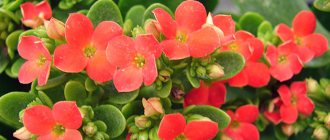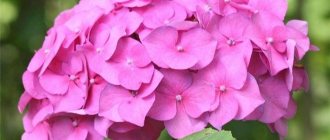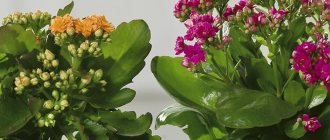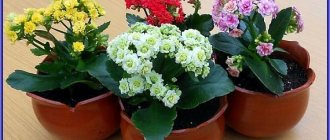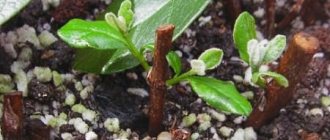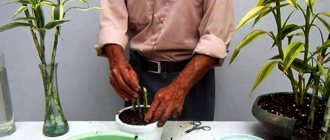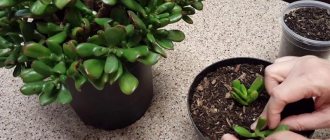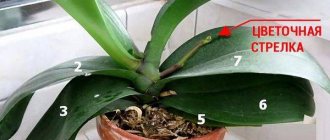Features of the plant
Succulents have many varieties and hybrid species. So you may come across both a woody plant and an ampel plant in the store. But the green friend will always have thick and juicy leaves of a pleasant green color. But their shape can be round, triangular, wavy, with small teeth and even even. There are species with edges, a waxy coating or speckled.
Home care
Kalanchoe will not require much effort from you to grow. It can go without water for a long time and does not require maintaining a certain temperature or humidity. In addition, it is a medicinal plant. So it will help in treatment at any time.
Location and lighting
Succulents need a lot of sun. It is only advisable to catch the morning and evening sun rays, and during the daytime either remove them from the windowsill altogether or shade them. You can place a flowerpot with a flower on the east or west window. In winter you can safely place it on a south-facing window sill. If you want Kalanchoe to bloom in the cold season, you will have to supplement it with light.
Temperature
The most favorable environment for a fleshy sprout is +17-19°C. But the flower can withstand a lot of coolness. The main thing is that the thermometer reading does not fall below +5-6 degrees.
It is desirable that the daytime temperature differs from the night temperature by several degrees. This is necessary for the formation of buds and better flowering.
But it is advisable to protect your pet from the heat. If the room is more than 20 degrees, the Kalanchoe will begin to absorb more liquid, and this can lead to rotting of the roots.
Watering
You should remember the main rule - it is better to underfill than to overfill Kalanchoe. The fleshy stems accumulate moisture, so the plant can survive without water for some time. And excess liquid can lead to the death of your green friend.
In summer, water when the substrate is one third dry, and in winter by 2/3, that is, almost completely. The water should be settled and cool. Pour in enough liquid to make the soil moist but not wet. In case of accidental overflow, be sure to drain the excess from the pan.
You need to water so that moisture does not fall on the leaves.
Air humidity
Kalanchoe, which does not like water, also reacts unfavorably to high humidity. The air in the room must be dry, otherwise it will rot and die. Only occasionally should you wash off the dust from the leaves.
The soil
For Kalanchoe, a purchased substrate for cacti or succulents is suitable. You can take universal soil, enriching it with expanded clay or perlite. You can collect the soil mixture yourself. You will need to take:
- 30% turf;
- 30% leaf soil;
- 30% river sand (coarse);
- 10% vermiculite.
Feeding and fertilizers
Kalanchoe does not need frequent feeding. It is enough to apply mineral fertilizer for succulents once a month. During flowering, you can fertilize it once a week, but in small portions. In winter, fertilizing should be stopped altogether. Make sure that there is some nitrogen in the composition, otherwise the bush may rot.
Transfer
A pot for Kalanchoe needs to be deep and wide, since the root system is not inferior in growth to the above-ground part. It is best to take a clay pot. The bottom of the container should be lined a quarter of the height with expanded clay or clay shards for better drainage. The diameter of the flowerpot should be 2-3 cm larger than the previous one.
The bush will have to be replanted every year in the spring, immediately after flowering. After removing the plant from an old pot with a small amount of soil, inspect the roots and get rid of any dried or rotten parts. Move to a new place of residence. In this case, the substrate must be identical to the old one. Place the bush so that the root collar is at the level of the soil mixture. And the upper edge of the flowerpot should protrude 2-3 cm above the soil. Add as much soil as needed and water the pet. Sprinkle a layer of pebbles on top. Adaptation to changing living conditions should take place within a week.
If you need to urgently replant a Kalanchoe during flowering, use the transshipment method. To do this, water the bush thoroughly, transfer it along with the earthen lump into another pot, and fill the remaining cavities with fresh soil.
Trimming
For the beauty of the bush, regular pruning and pinching is necessary. This should be done every spring or early summer after the plant has flowered. Particularly elongated shoots should be reduced by half or even two-thirds.
Those that are too bare will look unattractive, so it is better to cut them off to the base and root the top to form a new plant.
Possible problems associated with transplantation and their solutions
Improper care of transplanted Kalanchoe can cause the following problems:
- Kalanchoe has rather fragile stems and leaves, which can be damaged if handled carelessly during the replanting process. Therefore, you need to remove the flower from the previous pot as carefully as possible;
- Transplantation should be carried out only in spring, when Kalanchoe is in the active growth stage. If you transplant a plant at another time of the year, it simply will not take root;
- to avoid stagnation of moisture and the development of diseases, do not forget about drainage;
- The plant does not have a flowering period. This indicates an excess of nutrients. Reduce the number of feedings, apply fertilizers no more than once a month;
- Lack of light causes yellowing of the upper leaves. Kalanchoe should be placed in a place with good access to sunlight; If all the leaves turn yellow, including the lower ones, this indicates excessive lighting and the need to shade the flower;
- slowdown or lack of growth indicates a lack of nutrients and incorrectly selected soil composition. The flower needs to be transplanted into a new pot and provided with regular feeding.
Bloom
From mid-October to early March, when daylight is short, Kalanchoe produces many flowers. To get flowering in the warm season, you will need to “deceive” the plant, imitating darkness. To do this, for six weeks, you should hide the flowerpot with a flower in an unlit place every day and keep it there for 14 hours, and keep it in daylight for only 10 hours. In this case, watering should be reduced by half.
For flowers to form en masse, it must be +7 degrees at night, and no more than 16 degrees during the day. Make sure that the thermometer does not drop to +4 degrees or below. This can be fatal for your pet.
Under such conditions, Kalanchoe will bloom in 5-7 weeks. Once the bush blooms, resume normal care. Dried flowers should be removed. This will stimulate the development of new ones.
If you took a pot of Kalanchoe outside for the summer, then return it back to the apartment without waiting for frost. After 3 months it should lose color.
When you bring a bush from the store, do not immediately place it in the sun. First, shade with a piece of fabric. After a few days, begin to remove the cover little by little, gradually increasing the intervals in the light. Otherwise, the plant may drop its flowers, since the store is usually dim, and watering is done quite often.
What to look for when buying Kalanchoe
If you are going to immediately use the plant for medicinal purposes, you need to take it from friends or your grandmother at the nearest market, and not in a store. There, Kalanchoe is definitely stuffed with fertilizers or stimulants, which will not bring anything good to a person.
When purchasing decorative species, you need to pay attention to the following:
- The leaves should not have spots, spots, rot, or any other damage. Not often, but even reputable stores can receive a batch of plants infected with pests or diseases. No one will throw them away - this is a complete loss. Most likely, the flowers will be treated with a heavy dose of pesticides. But traces will remain, and, possibly, spores or larvae “hidden” in the leaf axils, substrate. Not only will gardeners bring an infected plant into the house, but it will also be weakened by a double or triple dose of the chemical.
- The leaves are elastic, uniform in color. The exception is variegated varieties. There should be no bald spots on the pubescent plates of Kalanchoe Becharian or Felt.
- A good sign is a point of growth in development.
- It is better to refuse the purchase if the Kalanchoe pot is too big. The crop is always sold in cramped shipping containers. The question arises: why was the Kalanchoe replanted?
- Experienced flower growers rarely buy a new plant (except for a very coveted one) unless they allow you to take the bush out of the pot and examine the roots. They should be white or dark straw-colored; a small number of dried shoots are allowed, but not rotten ones. The soil for Kalanchoe smells fresh, but should not stink - this is a clear sign of damage to the root system. Most likely, even if you immediately replant a plant from foul-smelling soil, it will not survive.
- The crop can easily be made to produce buds at any time, so you can buy flowering Kalanchoe not only in winter. It is better if the corollas are closed - by their color it is easy to see what the blossoming buds will be like. This way, at the peak of its decorative potential, the plant will last as long as possible. Bushes in full bloom look better, but will soon wither, especially since they will be exposed to stress from changing conditions.
Advice for transporting purchased Kalanchoe home in winter or late autumn:
- Ask the seller to wrap the entire flower in paper, for example, newspaper purchased in a nearby department.
- Place the Kalanchoe in a large bag.
- Inflate him.
- Tie so that no air escapes.
- Upon arrival home, first remove the bag, and after half an hour - the newspaper. All this time the flower should stand in the hallway.
- The next day it should not be transplanted, but quarantined.
The danger of purchasing Kalanchoe from hand is that it will be a cutting with poorly developed roots.
Reproduction
You can get new Kalanchoe plants in different ways:
- cuttings;
- leaves;
- seeds;
- children;
- kidneys;
- offspring.
You should choose a propagation method depending on the type of flower you grow.
Cuttings
You need to choose long shoots of at least 8-12 cm. Cuttings from apical shoots take root best. Rooting can be done in two ways:
- Cut off the cuttings and let them sit for 24 hours to dry. Remove the lower leaves. Moisten the soil in the pot and plant the cuttings in it. After 2-3 weeks it should take root.
- Prepare the cutting as described above. Then lower it into water so that half of the stem is in the liquid. The glass of water should not be in direct sunlight. When the roots appear after 2-3 weeks, you can transplant the sprout to a permanent place.
Leaves
Even a novice gardener can perform this procedure with consistent success. Cut the leaf and plant it in a well-moistened substrate. Cover the top with a glass jar. The roots should emerge within 3-4 days. After this, the plant will quickly grow.
For this purpose, you can even use fallen leaves if they have not dried out. You just need to root them in a glass of water. And after the roots appear, replant.
Seeds
This method should be used in the cool season. Sprinkle the seeds on top of the substrate without digging into the ground, just press lightly. Pour a trickle of water over the top to create a depression. Cover the top with a piece of cloth or glass. Avoid exposure to sunlight.
When the shoots appear, plant them in a box, covering the top with polyethylene. And only when 4-5 leaves are formed on the sprouts, plant them in small separate flowerpots. After a month, pinch off the tops. And then repeat this procedure after another 30 days. New plants should bloom in about a year.
Children
This method works best for pinnate Kalanchoes and Degremonas. It is in these species that babies are formed at the edges of the leaf edges, which have roots. Having matured, they fall off and take root in the soil mixture. All you have to do is wait until they have leaves and plant them in a container for rooting. When they gain strength, transplant them into separate flowerpots.
Axillary buds
Axillary buds appear in some species of Kalanchoe at the very hilum when the old leaf falls off. In appearance they look like small heads of cabbage. When it reaches 1-2 cm in height, trim it carefully and plant it in sandy soil. This will make it easier for the shoot to grow.
Offspring
After the Kalanchoe has finished flowering, pinch the apical shoot. Wait until new offspring appear next to the mother shoot. When they reach a third of the height of the mother bush, plant them in the substrate. Such sprouts take root well and grow quickly.
Appearance
Varieties of Kalanchoe share several main external characteristics:
- the root system is fibrous, with a short and branched rhizome; the roots are located in the upper part of the soil;
- dense, succulent stems are abundantly covered with foliage;
- the shape of the leaves varies depending on the type of succulent: oval, jagged, heart-shaped, narrow or lobed;
- the leaves are fleshy, rich green, less often dark purple;
- flowers are united in paniculate inflorescences, about 10 specimens in each inflorescence;
- the tree of life blooms with buds of yellow, red, white, purple or orange; flowers four-membered, erect or drooping;
- bears fruit with multi-seeded leaflets.
Most varieties of Kalanchoe grow and develop well under the supervision of plant growers.
Diseases and pests
Like any other indoor plants, Kalanchoe can be attacked by parasites.
- Aphid. You can get rid of small dark green insects by treating the bush with potassium soap. Too severely affected areas will have to be removed.
- Shield. Gray plaque should first be treated with an alcohol solution, then brush off the insects. Then repeat the alcohol treatment.
- Rot. If you find brown spots, stop watering for a while and partially replace the earthen ball. Then start watering with fungicides.
- Powdery mildew. White plaque appears due to too high air temperature. You will have to spray the bush with a fungicide solution.
- Gray rot. If you find weeping gray spots, you should partially replace the soil, treat the plant with a fungicide and move it closer to the light.
Care errors
If you care for Kalanchoe incorrectly, certain problems may arise:
- The bush doesn't bloom. This may be a consequence of too much fertilizer or too much daylight.
- The leaves curl. The cause may be thrips or leaf rollers. The bush needs to be treated with insecticides or miticide.
- Brown spots on leaves. Appear from excess ultraviolet radiation. Reduce daylight hours for your pet.
- Black spots on leaf blades. They provoke fungal diseases. The temperature in the room should be increased and the humidity reduced.
- Leaves are falling. Move the flowerpot away from the radiator or other heating source.
- The leaves turn yellow and dry out. Due to improper lighting.
- Withering of a flower after flowering. Urgent feeding or replanting is required.
100% way to make Kalanchoe bloom
As a rule, if you create conditions acceptable for Kalanchoe and properly care for it, buds will form at the right time. But sometimes, despite all the visible positive preconditions, it still does not bloom. There is a surefire way to get a capricious green pet to produce flower stalks.
The first buds appeared on Kalanchoe
To do this, the plant is forced into a state of hibernation:
- All stems are cut off radically, almost to the very base.
- Place the pot in a dark place for 4-6 weeks. You can put it in a closet, pantry, etc. It is better to wrap it in a thick fabric that does not allow light to pass through.
- Maintain the temperature around +15 °C.
- Stop watering and do not apply fertilizers.
- After the required time has passed, the flower is returned to its original place.
- They create a short daylight hours - no more than 8 hours, for which the plant is covered with a cap made of thick paper or a cardboard box.
- Raise the temperature to +18…+20 °C.
- Water at intervals - once every 10 days, after the substrate dries.
- Feed with specialized mineral compounds for succulents (according to instructions).
After such shock therapy, Kalanchoe blooms after a short period of time.
Folk signs
Kalanchoe is suitable for breeding for energetic and purposeful people. This is the kind of flower that will be conducive to achieving success and conquering new heights.
But for those who suffer from indecision, it would be useful to place a flowerpot with a succulent in their home. This will help you gain confidence in your abilities.
If you have problems in your family life, place a pot of flowers on the windowsill, and your feelings with your spouse will get a second wind. And for unmarried people, the fleshy leaves will help attract a groom.
If you notice that the Kalanchoe has begun to fade, you should know that damage has been caused to you or your home.
Medicinal properties
The juice of the fleshy leaves of Kalanchoe is used for external use both in official medicine and at home. Lotions and compresses made from it can be used in the following cases:
- boils;
- trophic ulcers;
- non-healing wounds;
- cracked nipples;
- sunburn.
For a runny nose, it is recommended to apply drops into the nose of adults and children.
In addition, the plant is able to kill harmful microbes floating in the air. So it wouldn’t hurt to place a pot of succulents in each room.
As you already understand, growing Kalanchoe is not difficult. The flower will not require special care from you. But it will always delight you with its beautiful flowering and beneficial properties.
